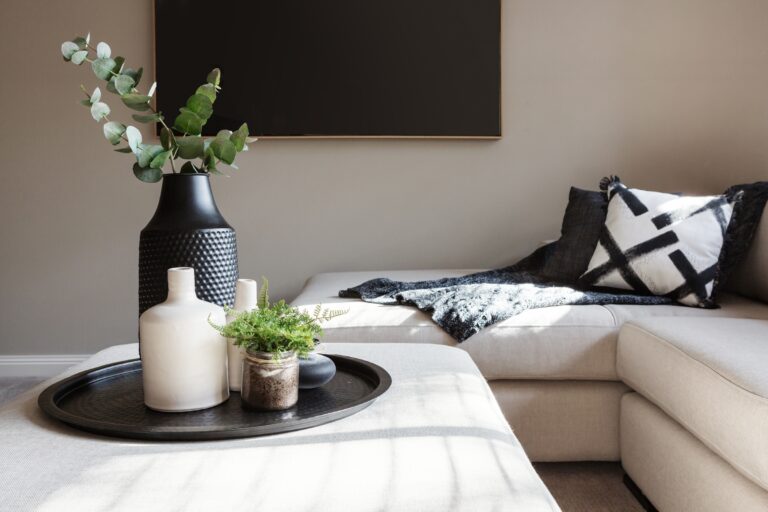E-design, which offers a flexible, accessible way to work with clients remotely, has been a game-changer for the interior design industry. But how does e-design differ from traditional full-service design? And how exactly do you go about launching your own e-design business, or adding it to your existing suite of services?
In this guide, we’ll explain the ins and outs of e-design, how it compares to full-service design, and walk you through 5 simple steps to launching your own online design business with ease.
Note: This article is designed to give you a quick look into the world of e-design. For a more comprehensive guide, check out our in-depth article on starting an e-design business in 2025.
Table of Contents
What is an online interior design business?
An online interior design business delivers its services via digital platforms rather than in person. Instead of physically visiting a client’s home or office, designers use photos, video calls, mood boards, 3D rendering software, and other online tools to provide consultations, design concepts, and floor plans.
This virtual approach offers convenience for both clients and designers, removing limitations like location and in-person scheduling and travel. It also allows clients to move at their own pace, making interior design more accessible and flexible than ever before.
Here are some services that many online designers choose to offer:
- E-design packages – Pre-set service bundles that often include a mood board, layout, product shopping list, and implementation guide, allowing clients to execute the design on their own.
- Virtual consultations – One-on-one design advice delivered via phone, video call, or messaging platforms, ideal for clients seeking quick guidance or second opinions.
- Full-room designs – Comprehensive online design services that include space planning, sourcing, styling, and revisions. These packages can transform a single room from start to finish.
- Styling and staging advice – Support for home staging or seasonal decor updates. These packages may suit clients prepping for a home sale or refreshing their space on a budget.
The flexibility of operating remotely empowers designers to scale their business more efficiently, tap into niche markets, and offer specialized services to clients anywhere in the world. Whether it’s a busy urban professional in need of a home office revamp or a vacation homeowner looking for coastal charm, an online interior design business makes high-quality design accessible, without the need for a single site visit.
Benefits of operating your design business online
Running an online interior design business offers a long list of advantages over traditional brick-and-mortar operations. Here are a few of the top benefits:
- Lower overhead costs: Without the need for an office or showroom, you can significantly reduce your operating expenses.
- Wider reach: There are no geographic limitations with an online business. You can work with clients across the country or even internationally.
- Increased flexibility: An online business model provides complete flexibility. You can manage your time more efficiently, schedule consultations during hours that suit you, and maintain a better work-life balance.
- Scalable business model: You can easily scale your online interior design business by offering pre-packaged services, hiring remote team members, or automating parts of your workflow.
How is an online interior design business different from standard design?
Both business models aim to create beautiful, functional spaces, but each follows its own unique approach. From communication methods to the services offered, here’s a look at what sets e-design apart from full-service
1. Communication
- E-design: Interactions take place via email, video calls, messaging, or design platforms.
- Full-service: In-person designers offer face-to-face meetings and on-site visits to discuss design concepts, assess the space, and build a strong personal connection with clients.
2. Design process
- E-design: Clients typically submit measurements, photos, and complete questionnaires. Designers then use design software to create mood boards, floor plans, and 3D renderings remotely.
- Full-service: In-person designers visit the space to measure dimensions, assess lighting, and get a tactile feel for the room.
3. Pricing
- E-design: E-design is often more affordable due to lower overhead costs and a more streamlined service model. Pricing is structured per room, on a flat fee basis, or in packages, making it easier for clients to understand and budget for their project.
- Full-service: Full-service generally involves higher fees, which may be hourly, fixed, or based on a percentage of the total project budget.
4. Scope of services
- E-design: E-design services focus on providing digital deliverables—layout plans, color palettes, furniture suggestions, and digital renderings. Clients typically assume the responsibility of purchasing, assembling, and installing the items themselves.
- Full-service: Full-service interior designers offer a more comprehensive package, often handling everything from start to finish. This includes project management, sourcing furniture and materials, coordinating with contractors, and overseeing the installation process.
5. Location
- E-design: Designers can work with clients anywhere in the world, as services are conducted remotely. This makes it an ideal choice for clients in different cities or even countries.
- Full-service: Full-service designers are typically limited to a local or regional area due to the need for in-person meetings, site visits, and on-site collaboration.
How to launch an online interior design business in 5 steps
Launching an e-design business doesn’t have to be complicated. You already have the skills—now it’s about deciding what services to offer and who your ideal clients are. Once that’s in place, you just need to ensure they can find you. Follow these steps to start your online business:
1. Define your niche and services
Before you find your first client, you’ll need to decide who you want to serve. Start by identifying the specific type of clients you want to work with and the unique challenges they face. Your niche could be based on style preferences, budget levels, or types of spaces. Some popular examples include:
- Small space design for urban apartments
- Sustainable interior design
- Affordable DIY-friendly e-design
- High-end luxury virtual design
Once you’ve chosen a niche, it’s time to create service packages that align with your strengths and meet your clients’ needs. Clear packages make it easier for potential clients to understand what you offer and how it benefits them. For example, you might offer a “$299 Studio Apartment E-Design Package” that includes floor plans and shopping lists, or a “$125 One-Hour Virtual Styling Session” for quick, targeted advice.
2. Build a portfolio
A strong portfolio is essential for showcasing your skills and attracting clients, especially when you’re new to online interior design. Here’s how to start building one effectively:
- Create mock projects: Design conceptual rooms or spaces that highlight your style, creativity, and problem-solving abilities. Use mood boards, 3D renderings, and floor plans to demonstrate your process.
- Offer discounted or free services: Work with friends, family, or local nonprofits at a reduced rate (or even pro bono) to gain real project experience. Be sure to request testimonials and permission to feature the work publicly.
- Include before-and-after photos: Visual transformations make a powerful impact and clearly show the value you bring to a space. Plus, the in-between photos add more content to your portfolio.
- Showcase your design process: Add mood boards, sketches, and client feedback to give potential clients insight into how you work and the thoughtfulness behind your designs.
- Gather client reviews: Collect and showcase positive feedback from clients to add credibility and build trust with potential customers. Authentic reviews highlight your professionalism and the quality of your work, making your portfolio even more persuasive.
3. Learn how to market your online design business
Effective marketing is essential to growing your online interior design business and standing out in a competitive digital space. Developing a multi-channel marketing strategy will help you reach your target audience, build credibility, and generate consistent leads. Some key approaches include:
- Instagram and Pinterest: Use these visually-focused platforms to showcase your design portfolio and connect with design enthusiasts. High-quality images and engaging stories help attract followers who could one day become clients.
- Email marketing: Build and nurture a mailing list by offering valuable content such as design tips, exclusive promotions, or updates about your services. Email allows you to maintain direct contact with interested prospects and past clients, encouraging repeat business.
- SEO blogs: Create blog posts optimized for relevant keywords like “home office e-design” or “coastal bedroom makeover.” This increases your website’s visibility in search engines, driving organic traffic and positioning you as an expert in your niche.
- Online communities: Engage authentically in Facebook groups, forums, and other design-related communities. Providing helpful advice and answering questions builds trust and can lead to referrals or direct client inquiries.
- Paid advertising: Invest in targeted ads on platforms like Facebook and Google to reach your ideal audience quickly. These ads can be highly customized based on location, interests, and demographics.
4. Build a workflow
A well-defined workflow helps you stay organized, meet deadlines, and ensure nothing falls through the cracks. While you can establish a workflow at any stage of your business journey, implementing one early on sets a strong foundation for efficiency and professionalism. Here’s how to begin:
- Map out your project process: Break down your process from the initial inquiry to project completion. Typical stages might include inquiry, consultation, proposal, design development, revisions, and final delivery.
- Create templates: Develop standardized documents for proposals, contracts, questionnaires, and invoices. Templates save time and keep things professional.
- Set clear communication points: Decide when and how you will check in with clients—whether through video calls, emails, or messaging apps—to keep them informed and involved.
- Use project management tools: Use project management tools to track tasks, deadlines, and client requests. Even a well-organized spreadsheet can work in the beginning.
- Automate wherever possible: Use scheduling tools like Calendly to manage appointments, and consider automated reminders to reduce no-shows and late responses.
If you want to streamline your process from the start, DesignFiles gives you ready-made templates for contracts, invoices, and questionnaires—plus built-in project management and communication tools. It’s an ideal platform for freelancers looking to deliver a polished client experience without juggling multiple apps.
5. Keep learning and evolving
The interior design industry is always changing. To maintain a competitive edge and continue delivering exceptional value to your clients, ongoing learning and adaptation are essential. Here are some ways to stay ahead:
- Attend webinars and online courses: Regularly participate in industry-specific webinars, workshops, and certification programs to deepen your knowledge and acquire new skills.
- Follow industry leaders and trends: Stay connected with thought leaders, design blogs, and podcasts to keep up with the latest styles, techniques, and business strategies.
- Update your portfolio and services: Routinely refresh your portfolio with new projects that reflect current trends and your evolving expertise. Also, consider expanding or refining your service offerings based on market demand and client feedback.
Note: This guide covers many important steps for building a successful online interior design business, and it might feel overwhelming at first. But the good news is you don’t have to do everything at once. Start by focusing on one key area—whether that’s defining your niche, building your website, or setting up your communication tools—and gradually implement additional steps over time. Consistent progress, even if it’s small, will help you steadily grow your business and achieve lasting success.
On the other hand, if you’re soaking up the facts and want to learn even more, head over to these guides next:
- How to Start an E-Design Business
- How to Start an Interior Design Business with No Experience
- How to Run an Interior Design Business
Building an online interior design business is an exciting opportunity to reach more clients, work on your own terms, and scale your impact. With the right systems in place, you’ll be set up to grow confidently and professionally.
Essential tools for online interior design
Good tools lead to greater success in the world of online interior design. Here are some platforms that can help you streamline your processes, communicate effectively with clients, and create stunning virtual designs.
1. Design and visualization tools
You’ll need tools to create floor plans, renderings, and mood boards. We recommend using DesignFiles, an all-in-one interior design business software, which offers everything from mood boards and 3D renderings to client questionnaires and invoicing tools. You can create detailed service packages, manage communication, and even accept payments—all from one dashboard. It’s designed to help online designers stay organized and look professional from day one.
- Mood boards, floor planner, and 3D renders
- Built-in, customizable product library
- Browser extension product clipper
- Ability to shop items and add affiliate links
- Task management features
- Client portals and team collaboration capabilities
- Contracts, quotes, invoices, and online payment processing
- Basic financial reports and QuickBooks integration
Other solid online design tools include:
- SketchUp (for floor plans)
- Coohom (for 3D renders)
- Canva (for moodboards)
2. Communication tools
Since you won’t be meeting clients in person, maintaining regular, transparent, and organized interactions becomes even more important. Fortunately, several digital tools can help streamline communication and keep your client relationships running smoothly.
- Zoom or Google Meet: for video consultations
- Slack: for ongoing client communication
- Calendly: for scheduling calls and meetings
3. Project management tools
Staying organized and managing deadlines is essential for the success of an online interior design business, particularly as you begin juggling multiple clients and complex projects. Here are some tools that can help:
- DesignFiles: for an all-in-one design business software
- Asana or ClickUp: for task management and organization
- Notion: for creating design processes and client guides
4. Financial tools
Using dedicated financial tools can streamline invoicing, contract management, and payment processing, allowing you to focus more on your creative work:
- DesignFiles: for invoicing, contracts, and payments
- QuickBooks: for in-depth accounting
- DocuSign: for legally binding digital signatures
Tips for growing your online design business
Growing a thriving online interior design business requires more than talent—you’ll need top-notch marketing, streamlined services, and strong client relationships. Whether you’re just starting out or looking to scale, these actionable tips will help you attract more clients, build credibility, and grow sustainably in the digital space.
- Leverage social media marketing: Regularly share before-and-after photos, time-lapse videos, and design tips on Facebook, Instagram, Pinterest, and other social media sites. These visuals help potential clients understand your style and build trust. Use hashtags strategically to reach niche audiences and engage with followers, fostering organic growth.
- Collect and showcase client testimonials: After each project, ask clients for a short review and permission to feature photos of the completed space. Publish these testimonials on your website, portfolio, and social platforms. Authentic feedback is one of the most persuasive tools for converting new leads into paying clients.
- Build an email list and nurture leads: Offer a valuable freebie—like a downloadable design guide, color palette cheat sheet, or room layout checklist—in exchange for email sign-ups. Use that list to share helpful content, promote new services, and stay top-of-mind with potential clients who aren’t ready to commit yet. DesignFiles also includes integrated marketing tools, such as branded email templates and a “Request Design Services” widget for your site, making it easier to convert leads and promote your services.
Don’t overwhelm yourself, just start with one manageable step. Once it feels natural, add another.
When you’ve implemented these and are ready to take your growth even further, head over to our complete guide to promoting your interior design business—it’s packed with everything you need to go from getting started to fully thriving.
Ready to streamline your workflow and grow your online interior design business? Try DesignFiles free today, no credit card required.


